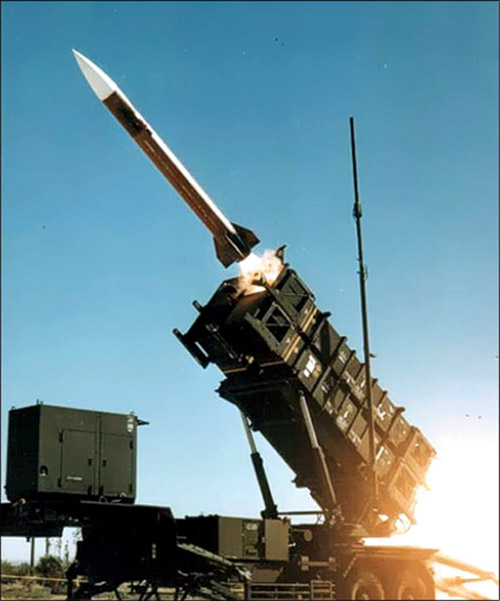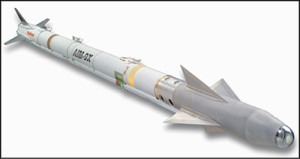LAHAT is an advanced laser-homing attack missile that makes use of semi-active laser guidance. The target in this case can be designated either directly from the launching platform or by another land based or aerial platform. It has an operational range of eight kilometres when fired from a ground platform and 13km when fired from an aerial platform, and has a hit accuracy of 0.7m CEP. It is in use in Germany, Israel and India.
Starstreak is a man-portable/vehicle-mounted high-velocity missile with 3.5Mach velocity, designed to counter threats from conventional air threats and fast pop-up strikes by helicopter attacks. It has an operational range in excess of seven kilometres and is currently in the inventory of armed forces of the UK, South Africa, Indonesia and Thailand.
RBS-70 is not susceptible to any deception by countermeasures employed by the target aircraft in the form of chaff or flares. It has an operational range of zero to six kilometres and a speed up to 1.6Mach. RBS-70 new-generation (RBS-70NG) includes an improved sighting system capable of night vision. RBS-70 Mk-2 upgrade is called Bolide missile. It is faster with a speed of 2Mach against 1.6Mach of standard RBS-70, and a range of eight kilometres as against six kilometres in the case of standard RBS-70. Fig. 6 shows RBS-70NG.

GPS/INS-guided weapons. GPS/INS-guided weapons make use of a multi-channel GPS receiver to provide information on the weapon’s location and an inertial measurement unit (IMU) to monitor its attitude to adjust its flight path to precisely hit the target. This is a low-cost means of precision targeting that is unaffected by weather and target concealment and is immune to countermeasures. These weapons are primarily used against fixed targets or relocateable targets whose location is likely to remain static for the duration of planning and attack.
In another role, GPS/INS guidance is also used to adjust a weapon’s free fall to hit a predefined point fed into the weapon, prior to launch. Yet another application of GPS guidance is in mid-course correction of guided missiles and cruise missiles. Precision in the basic weapons is characterised by a CEP in the range of one to ten metres. However, CEP is considerably improved when GPS is used together with a semi-active laser (SAL) or imaging infra-red (IIR) seeker head.
Guidance techniques
Guided weapons may use more than one guidance mechanisms for improved performance. The different guidance techniques include:
1. Beam rider guidance
2. Command guidance
3. Homing guidance
4. Navigation guidance
Homing guidance further comprises: semi-active homing guidance, active homing guidance, passive homing guidance and re-transmission homing guidance.
Navigation guidance further comprises: inertial navigation guidance, ranging navigation guidance, celestial navigation guidance and geophysical navigation.

Beam rider guidance. Beam-riding guidance of munitions is based on a radar beam or a laser beam, constantly pointed toward the target throughout the flight time of the munitions. After the missile is launched, it attempts to keep itself inside the beam, while the aiming station keeps the beam pointed at the target.
The missile’s flight path control functions as follows: The missile’s guidance sensors located at the rear of the missile receive information about the position of the missile within the beam. The missile interprets this information and generates its own correction signals. These correction signals are used to send command signals to the control surfaces of the weapon to keep the missile in the centre of the beam. The launch station keeps the beam pointed at the target throughout the engagement period and the missile rides the beam to the intended target. Both radar and laser beam rider guidance have been successfully employed for surface-to-surface, surface-to-air and air-to-ground weapons.
Fig. 7 illustrates the concept of beam riding for a surface-to-air weapon using a radar beam. Fig. 8 shows a laser beam rider missile launched from a helicopter against a tank target. As the beam moves farther away from the launcher and towards the target, it spreads out and it becomes difficult to keep the beam in the centre of the target. That makes the beam rider concept effective only for short to medium operational ranges.
Laser beam riding guidance became more attractive particularly for short-range anti-air and anti-tank missiles in the 1980s and 1990s with the introduction of low-cost and highly-portable laser designators. Laser beam riding also allows the designer to encode additional information in the beam using digital means. Laser beam rider missiles are inherently more accurate. Also, a narrow laser beam guiding the weapon makes it more difficult to be detected and therefore immune to countermeasures.







Top stories
Thank you for your feedback.